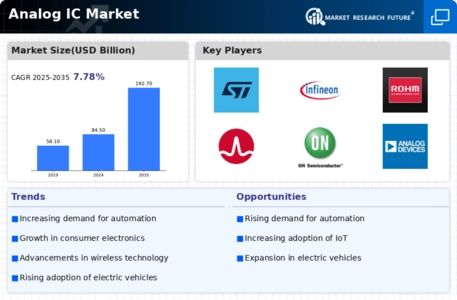Automotive Sector Advancements
The Analog IC Market is significantly influenced by advancements in the automotive sector, particularly with the rise of electric vehicles (EVs) and autonomous driving technologies. In 2025, the automotive segment is anticipated to represent around 25 percent of the overall analog IC market. This shift is largely due to the increasing complexity of automotive systems, which require high-performance analog ICs for functions such as power management, sensor interfacing, and communication. As automotive manufacturers strive to enhance vehicle safety and efficiency, the demand for specialized analog ICs is likely to grow, thereby driving the Analog IC Market.
Healthcare Technology Innovations
Innovations in healthcare technology are emerging as a pivotal driver for the Analog IC Market. The integration of analog ICs in medical devices, such as diagnostic equipment and wearable health monitors, is becoming increasingly prevalent. In 2025, the healthcare sector is projected to account for about 10 percent of the analog IC market. This growth is fueled by the demand for more accurate and efficient medical devices that rely on high-quality analog signal processing. As healthcare providers seek to enhance patient outcomes through technology, the reliance on advanced analog ICs is likely to intensify, thereby bolstering the Analog IC Market.
Rising Demand for Consumer Electronics
The Analog IC Market is experiencing a notable surge in demand driven by the proliferation of consumer electronics. As households increasingly adopt smart devices, the need for efficient analog integrated circuits has escalated. In 2025, the consumer electronics sector is projected to account for approximately 30 percent of the total analog IC market revenue. This growth is largely attributed to advancements in technology, which necessitate the integration of sophisticated analog components in devices such as smartphones, tablets, and smart home appliances. Consequently, manufacturers are compelled to innovate and enhance their product offerings to meet consumer expectations, thereby propelling the Analog IC Market forward.
Industrial Automation and Control Systems
The Analog IC Market is benefiting from the rise of industrial automation and control systems. As industries increasingly adopt automation technologies to enhance productivity and efficiency, the demand for analog ICs that support these systems is on the rise. In 2025, the industrial automation sector is expected to contribute significantly to the analog IC market, with a projected growth rate of around 12 percent. This trend is driven by the need for precise control and monitoring of industrial processes, which rely heavily on analog signal processing. Consequently, the Analog IC Market is likely to see sustained growth as manufacturers develop innovative solutions to meet the evolving needs of the automation sector.
Telecommunications Infrastructure Expansion
The Analog IC Market is poised for growth as telecommunications infrastructure continues to expand. With the rollout of 5G networks, there is a heightened demand for analog ICs that facilitate high-speed data transmission and improved connectivity. In 2025, the telecommunications sector is expected to contribute significantly to the analog IC market, with projections indicating a growth rate of approximately 15 percent annually. This expansion necessitates the development of advanced analog components that can support the increased bandwidth and lower latency required by modern communication systems. Thus, the Analog IC Market stands to benefit from these technological advancements.


















Leave a Comment